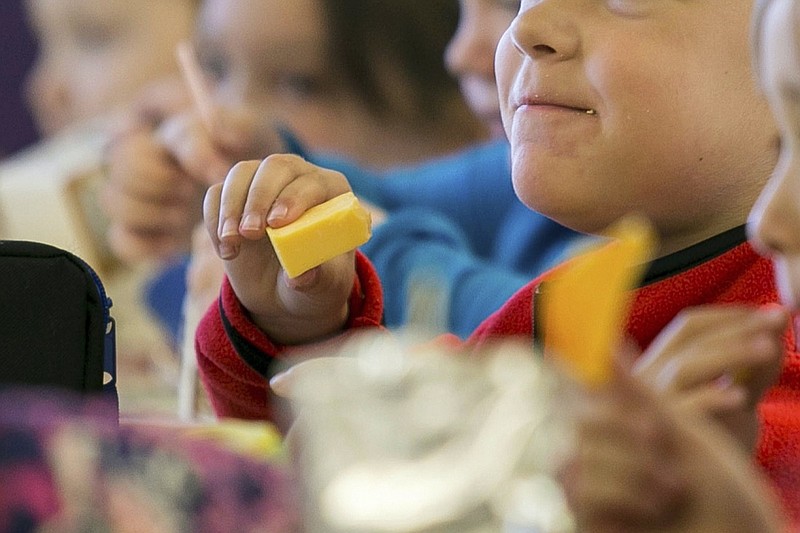The extension of a U.S. Department of Agriculture program will provide students in Chattanooga-area school districts with free breakfast and lunch for a second year.
School districts in Hamilton and Bradley counties in Tennessee and Whitfield and Catoosa counties in Georgia operated under the Seamless Summer Option program through the National School Lunch Program last year. The program was extended in April to cover meals for the 2021-22 school year until June 2022.
While the program is typically relegated to summer, school districts can use it next year through a waiver that was authorized by the Families First Coronavirus Response Act, said Kristen Nauss, school nutrition director at Hamilton County Schools, in an email Friday.
School districts applied for the program and cover the cost of labor and supplies, and the USDA reimburses districts for the total number of meals served to students.
Last year, Hamilton County Schools received $14.7 million in USDA reimbursements, and the system projects that total to be around $22 million for the coming school year. Knauss said the higher estimate comes from a higher reimbursement rate the USDA authorized for next school year, which will offset extra costs incurred by COVID-19.
Most districts saw an increase in meals served or students participating in the school lunch program in the past year.
In Catoosa County Schools, nearly twice as many students now qualify for free lunch. About 5,200 students qualified for free or reduced lunch in the 2019-20 school year, communications specialist Marissa Brower said in a Monday email. Last year, all 10,500 students qualified through the Seamless Summer Option program, which is not limited to low-income families.
Bradley County Schools saw a 38% increase in meals served last year compared to the 2019-20 school year. The district, which stayed open for in-person learning most of the year, served 1.8 million meals to students last year, said school nutrition supervisor Emily Brown in a Friday email.
Whitfield County Schools served 728,000 free breakfasts and 999,000 free lunches during the 2019-20 school year, said communications specialist Kristina Horsley in a Monday email. Last year, the district served 1.1 million free breakfasts and 1.4 million free lunches.
"We expect meal counts to stay the same or even increase in the coming school year," Horsley said.
At Hamilton County Schools, fewer meals were served since buildings were open less often, Knauss said. The district offered meal pick-ups or take-home meals for hybrid or virtual students, but there was less family participation compared to when students learn in person, she said.
The system served 6 million meals for the 2019-20 school year, and 5.2 million were free. Last year, the district served 4.8 million meals, all free, and Knauss said she expects the number of meals served to increase back to what it was before COVID-19.
"We anticipate more students returning to the classroom in 2021-22, so we expect our meals to return to pre-COVID numbers, with a possibility of a slight increase," Knauss said. "About half of our schools already participated in a program that offered meals to students at no cost, so we only anticipate a moderate increase in meals served in the other half of schools that were not participating in that program."
With the end of virtual or hybrid options, meal distribution methods established during the pandemic will change for some districts going into the new school year.
Dalton Public Schools and Whitfield County Schools had students eat in classrooms last year, spokespeople for the districts said, but they anticipate students will return to the cafeteria for meals in the coming year.
In Whitfield County Schools and Hamilton County Schools, spokespeople said some services put in place for virtual students last year, such as meal pick-ups, will likely not be offered this year due to students returning to the classroom.
Throughout the pandemic, school districts have worked with government organizations to offer meal benefits for students, including purchasing cards for families whose children were studying at home. The pandemic electronic benefits transfer (P-EBT) cards underwent a delayed rollout nationwide and in Hamilton County due to card processing errors.
The debit cards provided access to certain food types, including canned, fresh and frozen fruit and vegetables, dairy products, eggs, meat, rice and beans, for students who were not attending school in person.
Chattanooga-area community groups have also pitched in. No Kid Hungry, a campaign from the nonprofit organization Share Our Strength, awarded grants to schools and groups including the Chattanooga Area Food Bank and Sewanee-The University of the South to distribute meals to children in nearby counties.
Contact Anika Chaturvedi at achaturvedi@timesfreepress.com or 423-757-6592.
